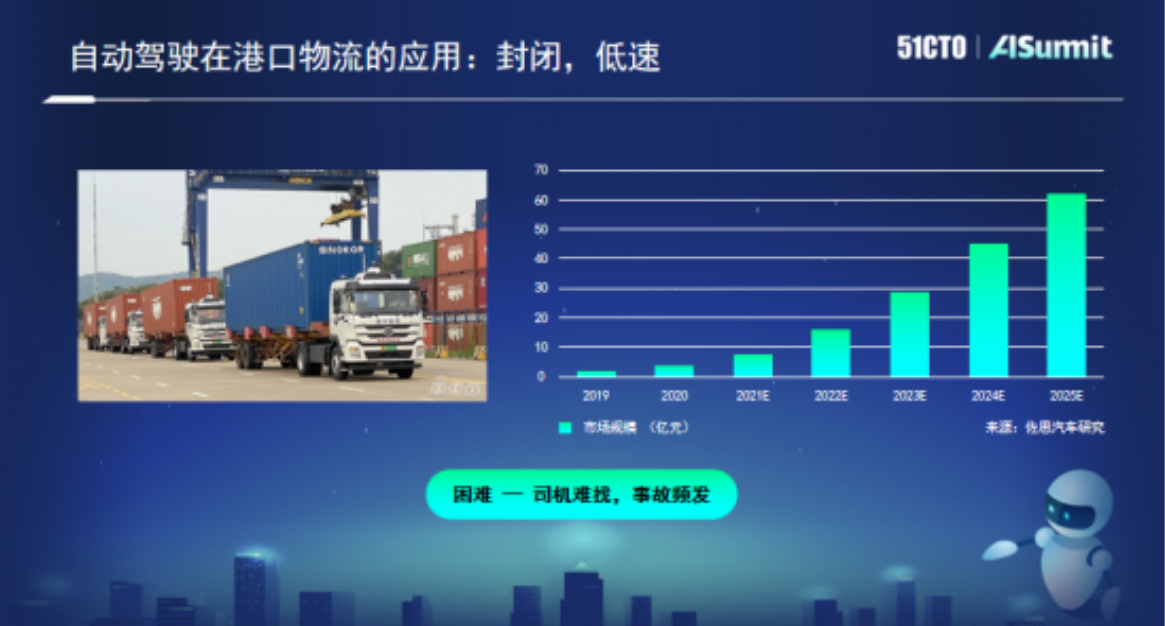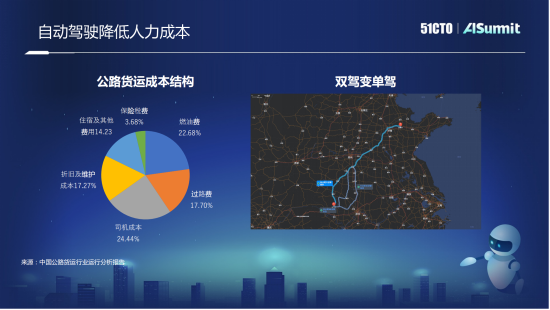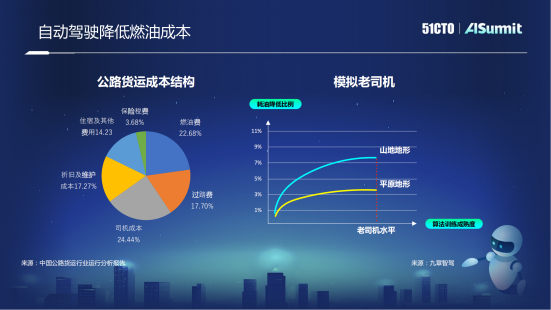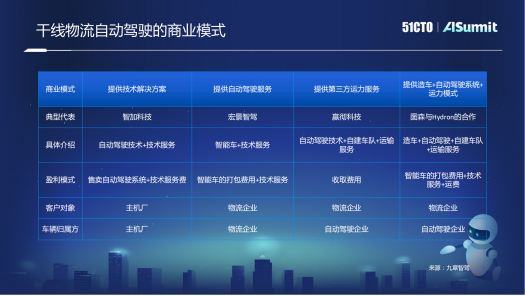FOR-U Smart Freight's CTO Chen Guanling Talks about Applications of Autonomous Driving in L 原创
Autonomous driving technology plays a crucial role in promoting smart transportation. Among various modes of transportation, road transport in line-haul logistics is relatively standard, therefore many experts believe that line-haul logistics may become a trial ground for autonomous driving systems.
As part of this year's AISummit hosted by 51CTO, Dr. Chen Guanling, CTO of FOR-U Smart Freight, presented a keynote speech entitled "Applications of Autonomous Driving in Line-haul Logistics", in which he explained how the application of autonomous driving technology could benefit the operation of line-haul logistics.
The application of autonomous driving in the road transportation
Modern society is based on a mature system of road transportation, which also reflects economic development of a country. In March and April, the COVID-19 pandemic-related lockdown once caused a temporary shortage of basic goods in some places. Throughout this period, much media coverage allowed many netizens to learn more about the road freight sector and truckers who played an essential role in delivering supplies.
In 2021, China's road freight market was worth 6.8 trillion CNY, and nearly 20 million truckers were employed. Road freight and GDP have a significant positive correlation, with a correlation coefficient of 0.86 between the number of active truck vehicles and GDP.
However, road freight also faces a number of challenges. In 2016, trucks accounted for 12% of all motor vehicles, yet the percentage of traffic accidents involving trucks exceeded 30%, with a fatality rate of 48%, according to the Ministry of Public Security. Additionally, due to the decline in freight rates, it is becoming more difficult for drivers to earn a living, and fewer young people would like to work as truck drivers.
A high frequency of vehicle accidents and a lack of drivers make autonomous driving an increasingly popular solution in the transportation industry.
- ?Application to port logistics.
The port environment is relatively closed and the driving speed here is relatively slow, which makes autonomous driving more feasible. However, most container trucks are still driven manually at ports, where the penetration rate for autonomous driving is less than 2%. By 2025, it is expected that L4 autonomous driving will have penetrated more than 20% of Chinese ports, with an application scale of 6,000 to 7,000 vehicles. Based on this estimate, the overall market size of autonomous driving in Chinese ports will exceed CNY 6 billion, accounting for about 30% of the global market.

The port logistics sector can be an important implementation site for self-driving trucks for two reasons: first, self-driving vehicles can be utilized in ports in a shorter term, and the business model is pretty straightforward, so it is expected that large-scale commercialization can occur within the next two to three years. Second, the experience gained from deploying self-driving trucks in ports could be extended to line-haul logistics within a year or two.
As of now, 13 Chinese ports have used self-driving trucks, and self-driving companies, including TuSimple, Trunk.tech, and Senior.auto have begun to promote the implementation and commercialization of autonomous driving technology in ports.
- Application to line-haul logistics
The highway logistics scene is more complex than the port logistics scene; however, it is still more friendly to autonomous driving than on open public roads in urban areas. In 2021, the heavy-duty truck ownership for line-haul logistics in China was about 3.14 million, and the market that could potentially be replaced by autonomous vehicles was close to CNY 760 billion, which is expected to reach CNY one trillion in 2025. It demonstrates that highway transportation for line-haul logistics has a much larger market share than port logistics.
Meanwhile, many industry leaders in the field have also laid out their plans, steadily promoting the commercialization of self-driving trucks. In December 2021, TuSimple completed the first driverless autonomous truck test on open public roads and planned to implement regular operations. In early June this year, Waymo—formerly the Google self-driving car project— announced a long-term strategic partnership to deploy autonomous trucks at scale on the Uber Freight network.
The benefits of autonomous driving for line-haul logistics
Besides safety, logistics companies' primary objective in utilizing autonomous driving technology is to reduce costs.
1. Reduction of labor costs.
It is estimated that the cost of drivers' salary accounts for 25% of the total costs of road transportation. Thus, after L4 automation is fully implemented, the cost of drivers might be eliminated, which would mean a significant decrease in overall freight costs of 25%. There is no doubt that the realization of L4 autonomy will take time, and we should be patient until both the technology and the policy are in place.

Moreover, drivers often feel fatigued after driving 600 kilometers continuously, and if the transporting distance exceeds 800 kilometers, two drivers must be employed in shifts. Therefore, it is hoped that the L3 automation could help reduce the burden on drivers and that transport tasks covering 800 to 1,200 kilometers will no longer require two drivers. In this way, the cost of transportation would be reduced by approximately 12% due to the use of only one driver.
2. Reduction of fuel costs
Fuel costs account for approximately 23% of total transportation costs. With the continuous increase in oil prices, that proportion is increasing. A lot of the time, fuel consumption is reduced by constantly adjusting the throttle of the engine so that the vehicle can achieve a reasonable amount of fuel injection. Generally, the percentage of fuel consumption reduction refers to the percentage of fuel consumption reduction of an automated vehicle compared to a novice driver.
Methods for reducing fuel consumption in autonomous vehicles include:
First, high-resolution maps and onboard sensors are utilized to learn about road conditions ahead (such as the number of uphill and downhill roads, and the speed of vehicles driving ahead) to make precise braking and acceleration decisions.

Second, collecting data and optimizing algorithms to ensure that a vehicle is driven in the best possible condition, aka the best power consumption range. During our studies, veteran drivers could consume 20% less fuel than novice ones, but they must be familiar with road conditions and know where to brake and accelerate when necessary. Therefore, autonomous driving can further reduce fuel consumption by 6% to 10%, reducing freight costs by 1.5% to 2.5%. Since many logistics companies typically have gross margins of 3% to 4%, a 1.5 percentage decline in costs is an effective way to increase gross profits.
Technical challenges of autonomous driving in line-haul logistics
1. Perception distance
The perception distance of cameras is approximately 200 meters, and that of a LiDAR is around 100 meters. Previously, Waymo reported that its vision system could detect and track objects up to 300 meters away, which is far enough for a car weighing up to two tons to brake safely while driving at high speeds.
However, when it comes to trucks, especially heavy-duty ones traveling at high speeds, we need to consider perception distance more carefully. Because the truck head alone may weigh more than nine tons, while the payload can be as heavy as 27 tons. Therefore, a longer perceived distance translates to a longer braking distance that will enable a heavy-duty truck to safely stop when braking.
Along with having a long perception distance, it is also vital to maintain detection accuracy, since using telephoto lenses to perceive distant objects may decrease resolution. As far as we are aware, no autonomous driving companies have disclosed this type of data at the moment.
?2. The challenge in lane changing
Changing lanes at high speeds may take a truck driver ten seconds, and this time could be multiplied when considering road conditions, thus increasing risks to other vehicles. A lane change is likely to be avoided in most cases, and we prevent safety hazards by making detections.
- Safe side shift.
If the driver of the car next to you does not wish to cut in, but the distance between your cars is too narrow, you will only need to give way slightly instead of changing lanes entirely.
- Unexpected cut-in.
In the event that another car suddenly cuts in, the car can also avoid a complete lane change if the decision system determines that the vehicle only needs to brake to slow down without crashing.
- Changing lanes proactively.
If other vehicles are merging from the entrance ramp of the highway and the decision system has determined that even slamming on the brakes will not prevent the collision, a proactive lane change may be the most effective strategy.
Each of these operations requires a reasonably accurate assessment of the intentions of other vehicles. Even so, the cargo inside the trailer behind the heavy-duty truck is unevenly distributed due to its weight and size, which could cause the vehicle to roll and then impacts the stability of lateral controls. Line-haul logistics presents a greater challenge in driving control, so the flight control system of self-driving vehicles must also meet an exceptionally high standard.
3. Data accumulation.
There is a common belief that driverless vehicles require more than 10 billion miles of road testing to reach the same level of safety as human operators. Autonomous driving routes in line-haul logistics may not cover the entire country at present, and vehicles may only be able to run back and forth on one line during the test phase. It is intended to collect data and verify the algorithm; therefore, the process of gathering data will take some time.
First, various routes contain different road information, making it impossible to use existing algorithm models for all lines. Second, as for development strategy, autonomous driving operators cannot operate multiple lines simultaneously when there are not a large number of vehicles. As a result, they will not develop algorithm models for new lines unless they have already developed successful algorithm models for current lines.
Simulation technology is an effective method for accumulating data. However, if simulation mileage is merely speculative, it is of no significance. A company may claim, for example, that a 1000 km simulation mileage is equivalent to a 1 km road test; however, this does not solve the fundamental problem: the core of this issue still depends on how to incorporate important events into the simulation system for testing and iterating the algorithm. A real-world road test and a simulation system are two essential elements in improving the algorithm's accuracy and enhancing the system's safety.
Business models of autonomous driving for line-haul logistics
Here are a few business models of autonomous driving companies in line-haul logistics.

- Business Model 1: Technology solution provider.
Companies that supply autonomous driving systems provide OEMs with a wide range of technical services, including sensor configuration solutions, the development and iteration of computing platform algorithms, etc.
- Business Model 2: Operation services provider(SaaS model).
Logistics companies(customers) purchase vehicles from OEMs cooperating with autonomous driving companies. Additionally, autonomous driving companies offer logistic companies related operational services, while logistics companies only need to manage the fleet and daily operations.
- Business Model 3: Third-party transportation service provider (Transportation as a Service, TaaS).
This model requires autonomous driving companies to build and operate their own fleet and to develop and iterate their technology.
- Business Model 4: Full-service provider (vehicle building+self-driving systems+transportation services).
Autonomous driving companies are required not only to provide a variety of autonomous driving systems and third-party transportation services, but also to enhance the capability of mass production delivery by producing a larger number of vehicles, thereby addressing the problem of insufficient transportation capacity.
At present, it is difficult to determine which of these four models is superior or inferior, as the industry is also exploring them. We believe that autonomous driving companies should dive deep into the business scenarios and have a direct role in the operation of line-haul logistics in order to better collect data and refine algorithms that will ensure the final product meets the needs of its operators.
The FOR-U approach to solving challenges in line-haul logistics
Self-driving is one of the aspects of line-haul logistics where a number of challenges remain.
Cargo owners may find that: it is inefficient to find vehicles; the price is opaque; dispatching delays occur; goods are hard to be tracked; and settlement is not standardized;
In terms of transportation capacity: it is challenging to improve transportation efficiency; there is a lack of standardized service capabilities; there is no guarantee of payment, etc.
A commercialized AI-based full truckload performance platform, FOR-U addresses these industry pain points with three smart systems: FOR-U Turing Smart Pricing System, FOR-U Compass Smart Dispatching System, and FOR-U Omen Smart Service System.

When the shipper requests a quotation, the platform will generate an automatic quote based on the algorithm, and the shipper may make an order if the price is acceptable. Upon confirmation of the order, FOR-U's intelligent dispatching system will select and assign the appropriate driver to take the order. For-U's smart service system allows the entire transport process to be monitored and ensure that all details have been logged online and no abnormalities have occurred.
Over the course of FOR-U's six-year operation, the accident rate is 0.02%. The punctuality rate is 95.2%, whereas it is generally only 80%-85% in traditional modes of operation. In addition, the deadhead rate is 6%, representing a considerable efficiency improvement compared with the industry average of 49%.
The vision of FOR-U is to create a truly intelligent operation platform for cross-city line-haul logistics, which will start from dispatching human-driven trucks today, to intelligent vehicles combining human and machine capabilities, and eventually, to completely driverless trucks.
Currently, FOR-U is implementing the Qimingxing Plan, which aims to open source business and operation scenarios for self-driving companies. Despite their technical backgrounds, these self-driving companies may lack experience in logistics operations, which causes them to spend more resources and energy on operations than on technology.
FOR-U will invite companies with self-driving trucks to join its commercial operation scenario. Under the Qimingxing model, FOR-U will be responsible for goods distribution, driver management, and delivery quality, while self-driving companies just need to focus on improving their technologies.

On the FOR-U operation platform, several key technical indicators will be fairly monitored, such as the average takeover mileage, fuel consumption in the self-driving mode, emergency braking speed, etc. Meanwhile, FOR-U may generate revenues for self-driving trucking companies since its shipping fee could be transferred to these companies. Additionally, FOR-U will also give preference to purchasing some trucks with relatively mature technical solutions.
Click on the following link to view the replay of AISummit: ??aisummit.51cto.com??
